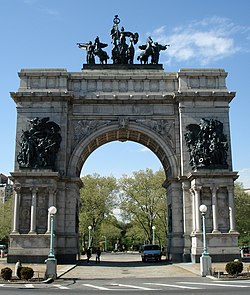Soldiers' and Sailors' Arch
| Soldiers' and Sailors' Arch | |
|---|---|
| Soldiers' and Sailors' Monument | |

The triumphal arch at the south end of the traffic oval (foreground). To the left and right of the memorial are additional streets (not shown).
|
|
| Type | American Civil War memorial |
| Location |
Grand Army Plaza Brooklyn, New York City, U.S. |
| Coordinates | 40°40′23″N 73°58′11″W / 40.672998°N 73.969842°WCoordinates: 40°40′23″N 73°58′11″W / 40.672998°N 73.969842°W |
| Elevation | 135 feet (41 m) |
| Height | 80 feet (24 m) |
| Dedicated | October 21, 1892 |
| Built | 1889-1892 |
| Built for | "To the Defenders of the Union, 1861-1865" |
| Rebuilt | 1898 (statues added) |
| Restored | 1976 |
| Architect | John H. Duncan |
| Sculptor |
Frederick Law Olmsted Calvert Vaux |
| Owner | City of New York |
| Website | www |
| Designated | October 16, 1973 |
| Reference no. | LP-0821 |
|
Soldiers' and Sailors' Arch location in Brooklyn
|
|
The Soldiers' and Sailors' Arch at the Grand Army Plaza in Brooklyn, New York City, is a triumphal arch dedicated "To the Defenders of the Union, 1861-1865". The eastern end with a stairway to the observation deck and crowning sculpture was open to the public until the early 2000s, when deterioration of the interior made it unsafe for the public.
On August 6, 1889, William R. Ware and Charles B. Atwood, who had been appointed by the Soldiers' and Sailors' Monument Commission, selected John H. Duncan's design for the arch from 36 designs submitted the previous year.
Frederick Law Olmsted and Calvert Vaux, in collaboration with architect Stanford White, built the arch after two-and-a-half months of site preparation; William Tecumseh Sherman was the speaker at the 1889 cornerstone, and President Grover Cleveland led the 1892 unveiling.
The McKim, Mead and White firm recommended the bronze statues for the City Beautiful movement, and Park Commissioner Frank Squire engaged Frederick MacMonnies in 1894 to design the three bronze sculptural groupings. The interior arch faces have equestrian bas-reliefs of Abraham Lincoln and Ulysses S. Grant sculpted by William Rudolf O'Donovan (men) and Thomas Eakins (horses), that were added in 1895. Also added in 1895 by sculptor Frederick MacMonnies are the Army and Navy sculptures and the allegorical crowning sculpture. This sculpture depicts the winged goddess of victory, following victorious combat (the Civil War) with instruments of war: sword, colors, flagstaff, and quadriga (the Union Army). Winged attendants are seen removing two of the four quadriga horses for peacetime use (postbellum recovery) while trumpeting the victory and freedom (Emancipation).
...
Wikipedia

